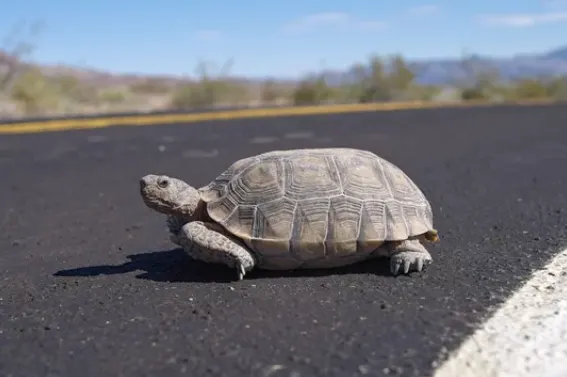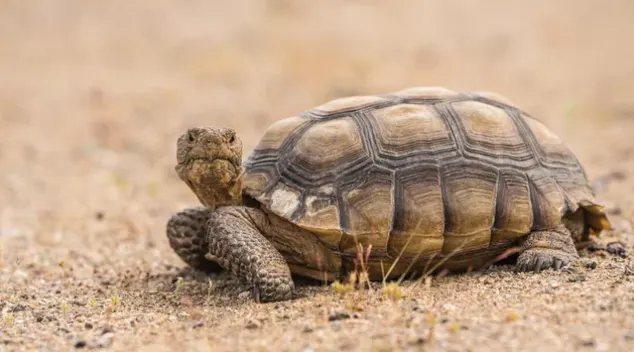The Desert Tortoise (Gopherus agassizii) is a remarkable creature built to withstand the harsh conditions of its desert habitat. Found primarily in the southwestern United States and northwestern Mexico, this slow-moving reptile spends most of its life in underground burrows, avoiding extreme temperatures. Despite its solitary and shy nature, the desert tortoise has fascinated scientists for decades due to its unique adaptations and long evolutionary history.

Table of Contents
Key Characteristics
- Scientific Name: Gopherus agassizii
- Family: Testudinidae
- Lifespan: 25-60 years in the wild, potentially up to 80 years!
- Speed: 0.3 mph (yes, they’re slow!)
- Diet: Herbivore, mainly grasses and flowers
- Habitat: Dry desert plains and rocky hills
The Desert Tortoise: A Master of Adaptation
Desert tortoises have evolved to thrive in an unforgiving environment. With temperatures soaring above 105°F in their habitats, staying cool is essential. To combat the heat, they spend around 95% of their life underground, burrowing into the desert sand to escape the extreme climate. In fact, they’ve been known to dig grooves in the sand to catch and store rainwater, ensuring they stay hydrated even when water is scarce.
Fun Fact: After a good drink of rainwater, a desert tortoise can go without needing water for up to a year!
Evolution and Origins
The evolutionary history of the desert tortoise is fascinating. Fossil evidence shows that tortoise ancestors existed over 50 million years ago! During this period, tortoises lived in a variety of environments, from forests to grasslands. However, as deserts began to form in North America, desert tortoises adapted to the arid environment by developing thicker shells and efficient water conservation methods.
Their lineage likely diverged from other tortoise species between 8 to 15 million years ago, as isolated populations adapted to different desert conditions.
Physical Appearance and Size
With their thick, patterned shells, desert tortoises are built to withstand the elements and fend off predators. Their shells are typically brown or gray with a yellowish underside, helping them blend into their surroundings.
- Length: 10-14 inches
- Weight: 8-15 lbs (about the size of a small bowling ball!)
They may seem slow and heavy, but their shell plays an essential role in survival. The dome-shaped shell not only protects them from predators but also helps retain moisture and regulate body temperature in the scorching desert heat.
Sensing the World: How They Hear and Feel
Interestingly, desert tortoises don’t have visible ears! Instead, their eardrum is located on their neck, beneath a layer of scales. They rely on vibrations in the ground to “hear” what’s happening around them. These vibrations travel through their legs and shells to their eardrums, making them keenly aware of their surroundings despite their apparent sluggishness.
Lifestyle: A Solitary Existence
Desert tortoises are solitary creatures, often spending their time alone except during breeding season. However, during colder months or extreme weather, they may share burrows with other tortoises for warmth and protection. When a group of tortoises gets together, it’s called a “creep.”
Despite being solitary, desert tortoises engage in intricate burrowing behaviors. Their strong, sharp claws and sturdy front legs are perfectly designed for digging in the tough desert soil. These burrows provide refuge from the desert’s extreme temperatures, allowing tortoises to escape the midday heat or winter cold.
Diet: What’s on the Menu?
The desert tortoise is a herbivore, primarily feasting on:
- Grasses: Rice grass, Bermuda grass, ryegrass
- Wildflowers: Primrose, sow thistle
- Cacti: Including cactus fruits
Their slow metabolism means it can take 20-30 days to digest a meal fully! Desert tortoises are known to forage for hours, pulling grasses from the ground with their tough, scaly feet.
Fun Fact: Tortoises play an essential role in desert ecosystems. As they move and forage, they leave behind their droppings, which help spread plant seeds and encourage new growth.
Predators and Threats
Even with their thick shells, desert tortoises face numerous predators, especially as hatchlings. Common predators include:
- Coyotes
- Foxes
- Ravens
- Gila Monsters
Adult tortoises are less vulnerable due to their size and ability to retreat into their shells. However, hatchlings with soft, undeveloped shells are easy targets. To defend themselves, tortoises may release urine when threatened, which can deter predators. The downside? This means losing valuable water reserves, which can be dangerous in the arid desert.
Reproduction and Lifespan
Desert tortoises have a unique reproductive cycle. During the breeding season, males compete for females, sometimes flipping each other over to display dominance.
- Gestation period: 3-4 months
- Clutch size: Up to 14 eggs
- Hatching season: August to October
Hatchlings are born about 1.5 inches long and weigh less than a pound. Sadly, many hatchlings don’t survive to adulthood, with only 1 to 5 out of 100 reaching maturity due to predators and environmental challenges.
Desert tortoises can live for 60-80 years in the wild. In captivity, where they are protected from predators, some may live even longer.
Conservation: A Threatened Species
The desert tortoise has faced a dramatic population decline in recent decades, primarily due to:
- Habitat loss: Construction projects, landfills, and expanding human activity
- Predation: Especially targeting hatchlings
- Diseases: Upper respiratory illnesses have affected both wild and pet tortoises
Since 1990, the desert tortoise has been listed as a threatened species under the U.S. Endangered Species Act. Their population has decreased by 90% since 1980. Today, approximately 150,000 desert tortoises remain in the wild, but conservation efforts aim to protect their fragile ecosystems.

Can Desert Tortoises Be Kept as Pets
While it’s legal to own a desert tortoise in some places, it’s not recommended. These creatures require specific diets and environments that are difficult to replicate at home. Additionally, released pet tortoises may spread diseases to wild populations. If you’re considering owning a desert tortoise, remember they can live for over 60 years, making them a lifetime commitment.
Respecting Nature’s Survivors
The desert tortoise is an extraordinary example of survival and adaptation. Their ability to endure the harshest conditions while playing a vital role in their ecosystems is a testament to nature’s resilience. While their future faces challenges, ongoing conservation efforts give hope that these ancient reptiles will continue to roam the deserts for generations to come.
Fun Fact to End On: The oldest recorded tortoise, named Jonathan, is believed to be 185 years old!
- Enchi Ball Python: A Unique and Stunning Morph of Python regius - March 27, 2025
- Emerald Tree Monitor: The Enigmatic Green Guardian of the Rainforest - March 26, 2025
- The Egyptian Cobra (Naja haje): A Fascinating Serpent - March 25, 2025
